TechRadar Verdict
With a premium build quality, a gorgeous screen and dual-booting OS, the Anbernic RG552 is an excellent option for those looking for a dedicated handheld device to enjoy gaming generations of old – and some lighter Android fare. However, more powerful alternatives wait just over the horizon.
Pros
- +
Wonderful screen
- +
Excellent build quality
- +
Great retro performance and customizability
Cons
- -
Expensive
- -
Performance on newer systems could be better
- -
Needed stacked shoulder buttons
Why you can trust TechRadar
You may not have heard of Anbernic, but for several years the gaming hardware manufacturer, based out of China, has been quietly amassing an army of fans thanks to the excellent retro handhelds it has been developing.
From the RG350 to the RG280V and many more inbetween, it’s built a solid reputation for putting out superb, affordable Linux-based handhelds purpose built for retro gaming, with build quality far beyond expectations.
Its latest device, the Anbernic RG552, is its most advanced and ambitious yet – a high definition touchscreen portable that can dual-boot between a gaming-focussed Linux OS and full blown Android. With more powerful internals than Anbernic has put out before, and capable of emulating games ranging from the early noughties to decades prior, as well as handling modern game streaming platforms, it’s a one stop shop for gamers of all ages and creeds.
It falls just short of perfection, mostly thanks to the higher price it commands, greater than has come to be expected of devices like this. But thanks to a dedicated community of tinkerers, these early days after its launch may represent just a fraction of the potential the RG552 may have in the coming months.
Thanks to Droix.co.uk for supplying the Anbernic RG552 sample used in this review.
Note that the Anbernic RG552 doesn’t ship with any games, and that the downloading and distributing of ROMs is a well-documented legal grey area.
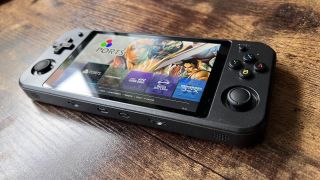
Price and availability
The Anbernic RG552 is available now. Pricing varies depending on where you look to purchase the device from – buy direct from Anbernic through its website and expect to pay about $227 / £170, before import taxes are added – and a lengthy shipping wait from China is endured. Buy directly from a reseller like Droix however and you’ll pay £209.95 (about $280), and have the benefit of next-day delivery options.
Either way, that’s much pricier than Anbernic products of old. In comparison to earlier models, that price is justified – there’s a bigger, higher-resolution screen on offer, and more powerful internals. But equally powerful, if not even more powerful, competition like the Ayn Odin sits just around the corner from release, at a similar price point. For now, the Anbernic RG552 remains competitively priced, but that may not be the case in a few months' time.
Design
The Anbernic RG552 is one of the bigger dedicated retro handhelds on the market. Similar in size to a Nintendo Switch Lite, it features a 5.36-inch touchscreen with a HD resolution of 1920 x 1152 that’s responsible for the larger size. That results in a slightly strange 5.3 aspect ratio, but it’s one that actually benefits the majority of the retro content you’ll be playing on the device, as you’ll be able to use pixel-perfect integer scaling to increase the resolution of even the oldest systems, while minimizing the black borders that surround games not intended for high resolutions.

It’s wonderful to look at too. Though the responsiveness of the touchscreen is sometimes questionable, colors are vibrant, black levels are deep and inky, and viewing angles are wider than you’ll need for standard solo play. Scaled up using accurate integer pixel scaling options, image quality for retro games on the Anbernic RG552 is phenomenal.
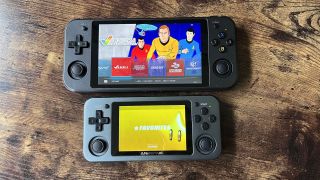
If you’re familiar with earlier Anbernic devices like the RG351P or RG351M, the RG552 will look very familiar. You have symmetrical-placed, clickable dual analogue sticks (similar in style to those found on a Nintendo Switch), an excellent, responsive D-Pad and X, Y, A, B buttons that have a wonderful, spongy action. L1, L2, R1 and R2 buttons sit on the top, with the pairs adjacent, as opposed to stacked. This makes the L2 and R2 buttons quite small, and difficult at times to reach. A select button sits above the D-Pad, and a Start button above the X, Y, A, B buttons.

A volume rocker button sits on the left hand side (with a slightly disconcerting rattle – the one weak spot in an otherwise sturdy build), while the power button sits on the left. Stereo speaker ports sit on the bottom, as well as the two SD card slots, a reset button and a ‘Function’ button that can be used in conjunction with the face buttons to map in-game and in-emulator hotkeys. These last two buttons can be easy to confuse without looking, so be careful not to accidentally reset your game at a key point fumbling for that Function button – expect custom firmware to change this before too long. That Function button also doubles as a physical ‘Home’ button once you jump to the Android side of the software combo.

The top edge houses the 3.5mm headphone jack, as well as two USB-C ports (one for charging, one for plugging in external accessories like gamepads) while a mini HDMI port lets you mirror the action on a bigscreen TV. Finger grip pads sit on the back too – handy for stopping the handheld slipping around on a table top.
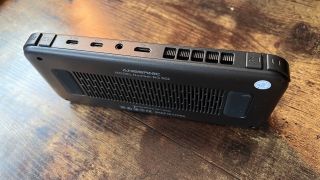
Audio output is loud and clear, with the speaker grill placement smartly sat away from the muffling effects of your fingers. There’s also rumble onboard – dual motors either side of the screen, impressively – but don’t go expecting PS5 style DualSense levels of subtlety here. It’s more akin to a phone’s vibration.
The overall size of the RG552 means it’s not exactly pocketable. Measuring 20 x 8.5 x 2cm and weighing about 350g, it’ll need a safe spot in your rucksack when out and about. The larger size has both positives and negatives. The screen is large and gorgeous to look at – perfect especially for systems with a wider ratio, like GBA or PSP. But the added height of the screen makes it hard to hit the side-by-side shoulder and trigger buttons, while using the sticks and face buttons at the same time. Stacked shoulder buttons are increasingly seeming like a must for devices of this size, and while it’s understandable that Anbernic would continue with its previous design language, a shift to accommodate the larger size would have been wiser.
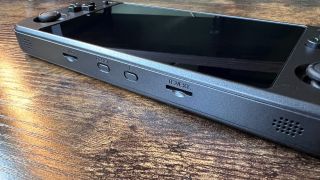
Under the hood, Anbernic has finally upgraded from the RK3326 system on a chip set up that has been the bedrock of its devices for a long while now. Anbernic has instead opted for a RockChip
RK3399 chip this time - a six core processor, with two cores clocked at 1.8GHz, four at 1.4GHz, backed by 4GB of RAM. The GPU is a Mali-T860 MP4 clocked at 600Mhz. While this may seem tame in comparison to your average Android smartphone, this is a powerful set up for a dedicated handheld device. As mentioned earlier however, the likes of the Ayn Odin, with its SnapDragon 845 8-core / 2.4GHz processor, will run rings around this setup.

In order to push this chipset to its limits, the Anbernic RG552 is one of the first handhelds to feature an active heatsink in the shape of a fan. Vents on the rear or the handheld and top of the device draw in and push out air to keep internal components cool, kicking into gear depending on how demanding the current content you’re trying to run is. Fan noise is low and tolerable, though you’ll feel the intake of air against your fingers on the rear.
64GB of built in storage is onboard for the Android side of things, while a 16GB microSD card is included for the Linux OS side. A second SD card slot is available too for storing your games and content, but you’ll need to supply that card yourself.
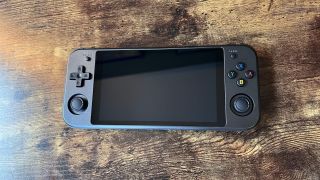
Shipping with a USB-C fast charger, a much appreciated addition, two onboard batteries combine for a total of 6400mAh. Battery life in action will vary, depending on what you’re playing, and on which operating system side you’re playing on. But expect between 3-5 hours of play time – and on the lower end of that scale for 3D games.
The lack of Bluetooth here is frustrating though – it prevents the use of wireless headphones or external wireless controllers, annoying given the microHDMI output to a TV is great and otherwise suitable for using the RG552 for a console-like experience. Likewise, the inclusion of just the 2.4GHz Wi-Fi band may lead to some spotty streaming performance depending on your home network set up.
Software and features
The RG552 offers the somewhat unique option of booting into one of two operating systems – the Linux-based, gaming-focussed Batocera (which integrates emulators, game art and metadata into a wonderful jukebox-like retro gaming front end) and Android 7.1, which is accessible by removing the Linux SD card when booting the console up, and runs with a pre-installed ATV Launcher which introduces a tile-like interface which is reminiscent of Android TV. After some early software hiccups at launch, the Anbernic RG552 now ships with updated firmware that fixes some early adopters most complained about issues – namely audio lag on the Batocera side, and the lack of Google Play Store access on the Android side, both now resolved.

Depending on your gaming preferences, you’ll be jumping between the two operating systems regularly. Batocera is a simply wonderful gaming interface, with a built in metadata scraper pulling in videos, artwork and descriptions for all your games, while pulling the various RetroArch emulator cores for various platforms into one easy-to-use system. Pop a few games into the corresponding SD card folders and you’re away, though dig a little deeper and OS becomes very customisable, with different themes, layouts and in-game presentation options to play with.

The Android side is a little less charming – it’s basically just an app launcher, after all, though you can always add a similar front end for artwork from the Play Store, such as the excellent Dig or Reset Collection apps. Where it comes into its own though is with emulator apps for newer 3D systems. Put simply, Android development for 3D systems (we’re talking the PS1 and above) outstrips what’s happening on the Linux side. So if you fancy firing up a Dreamcast game for instance, you’ll want to jump into Android’s ReDream emulator.
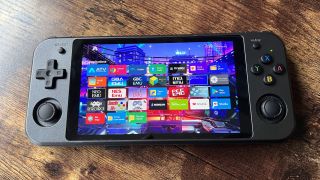
It’s worth noting however that we’re sad to see some paid-for Android emulators appear on the device license-free. We’re not convinced that the developers have been compensated for their efforts, so we’d encourage you to purchase them through your own Google account if you haven’t already.
For the uninitiated, it’s worth pointing out that much of the appeal for retro hardware like this is to see what the development community does with creating custom firmware for the devices. What Anbernic puts forward here is, for better or worse, a building block foundation for others to riff on. Even just shortly after launch custom firmware options, unlocking new features for the device, are starting to appear online. And while we can’t pass review judgement on something that doesn’t ship in the device, we’re confident that a wide array of OS options will arrive in the near future for RG552, with all manner of accompanying new features. Just look at the community that’s built around the RG351 devices for what’s possible in this respect. The excellent Retro Games Corps already has a guide to some early tweaks that can be made.
Performance
If you’ve used an Anbernic product before, you’ll be pleased to know that the RG552 represents a significant boost in performance, from both its Linux OS side and the new capabilities opened up through its Android side.

If you’re looking to play any game from the pre-8-bit, 8-bit, 16-bit, 32-bit or 64-bit eras (basically anything from the Atari through to the Nintendo 64, plus any 2D arcade games and a smattering of 3D ones, too), you’re in for a treat. Whatever title within that window that we threw at the Anbernic RG552, it handled it with aplomb without dropping a frame and, in the case of most of the 2D titles and some 3D titles, with the resolution scaled by a multiplying factor. These games have rarely looked this good, with a combination of software screen filters and high resolution output making them look how you remembered them, through your rose tinted glasses, not how they actually were.
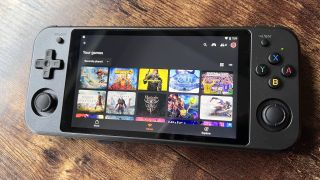
It gets trickier beyond that point however. Dreamcast games run well at a native resolution, and many are enjoyable at a 2x resolution upscale. But you’re going to struggle to upscale PSP, while any system or Android game that requires touchscreen input is going to be hampered by a somewhat-temperamental touchscreen. And while other handhelds are starting to delve into Gamecube and PS2 emulation, that’s completely out of reach of the RG552. What is supported is supported is handled superbly though – whether its upscaling the odd Dreamcast game, or tricking 4:3 PlayStation games to run at high resolution in a 16:9 ratio without stretching and instead extending the bounds of the play space, it’s a retro gamer – and tinkerer’s – heaven.

That’s before considering the streaming side of things. Provided that your internet connection is up to speed, you can enjoy the likes of Stadia streaming, or PC game streaming over a home network with Moonlight, on the RG552. Having the aforementioned retro capabilities sit alongside these future-gazing streaming platforms is wonderful, if slightly hindered by the lack of 5GHz Wi-Fi options.
Verdict
If you’ve never played with a retro handheld before, the Anberinc RG552 will be a revelation.
With a build quality to rival the Nintendo Switch, it’s a customisable time machine for tapping into the greatest titles four decades of gaming has to offer.
It requires some tinkering and set up prowess to get it working at its best, making it best suited for those that enjoy a project as well as a play around. Once set up to your liking however, it reveals itself to be a near-complete gateway to all sorts of gaming experiences, from 8-bit classics to modern streaming delights.
However, its price to performance ratio is off slightly – we’d expect it to run more advanced emulated software than it is capable of for the price, with beefier internal specs, and its lack of stacked shoulder buttons can make playing games that require a lot of shoulder button work uncomfortable.
It’s also launching just as a new wave of retro handhelds are arriving, which look to offer wider software support and better emulation capabilities, like the Ayn Odin and Retroid Pocket 2 Plus. Each has their pros and cons, but as it stands today, the Anbernic RG552 is about as good as retro gaming on the go gets – it’ll be fascinating to see what the very-active dev community does to lift its capabilities even higher.
Gerald is Editor-in-Chief of iMore.com. Previously he was the Executive Editor for TechRadar, taking care of the site's home cinema, gaming, smart home, entertainment and audio output. He loves gaming, but don't expect him to play with you unless your console is hooked up to a 4K HDR screen and a 7.1 surround system. Before TechRadar, Gerald was Editor of Gizmodo UK. He is also the author of 'Get Technology: Upgrade Your Future', published by Aurum Press.

A key Apple app is rumored to be getting a major upgrade in macOS 15

Intel's formidable 288 core CPU now has a proper family name — Granite Rapids and Sierra Forest are Xeon 6 processors but is it just becoming too confusing?

Get six months of Disney+, Hulu, and ESPN+ free at Verizon with this epic deal

